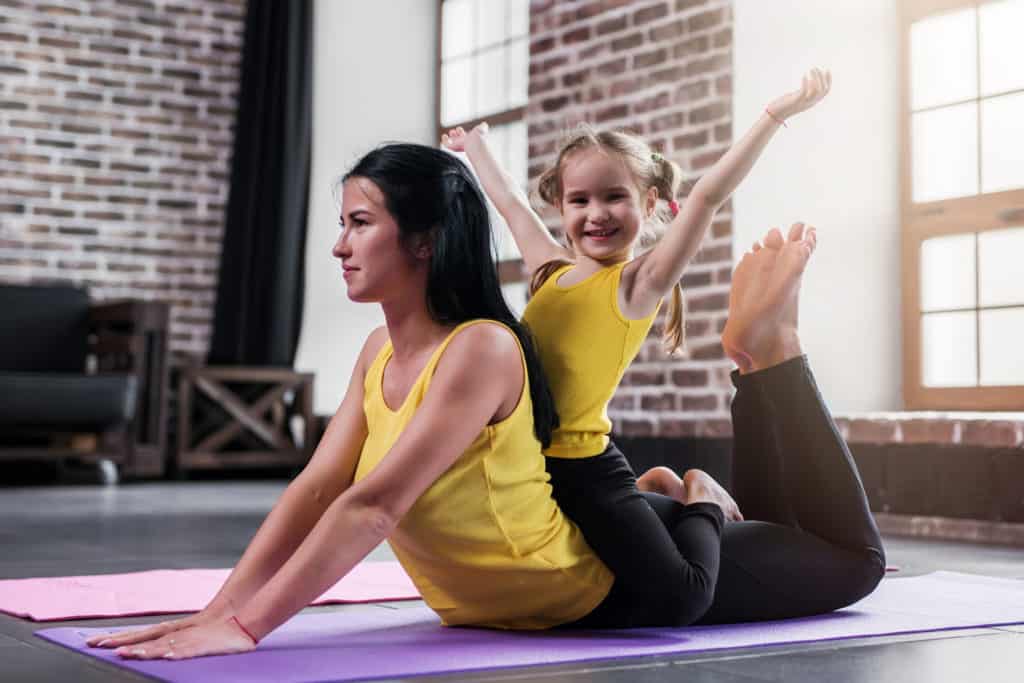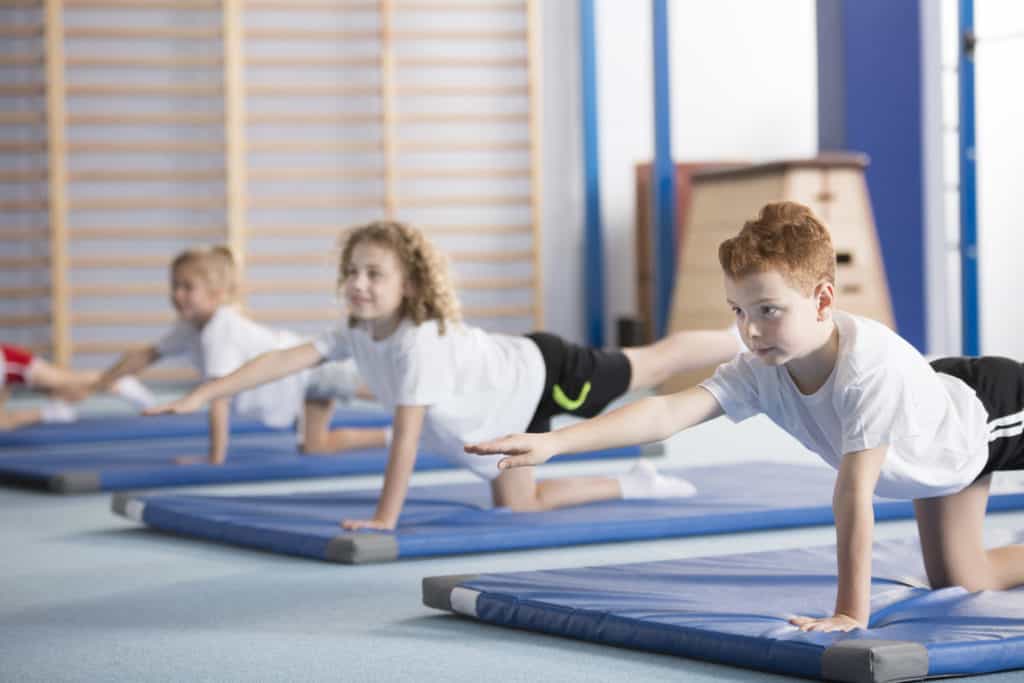This article is evidence-based, verified by John Cottrell, Ph.D. in Clinical Psychology
Yoga is helpful when working with many physical and mental conditions. These can range from healing from knee replacement surgery to managing symptoms of depression and anxiety. Both scientific and anecdotal research indicates the benefits of yoga as a supplemental treatment for many people. Autism is a particular area of interest.
According to the Centers for Disease Control (CDC), autism affects an estimated 1 in 59 children in the United States. A question to ask is whether yoga is helpful for an adult or child that lives with autism. This article will look at how the philosophy and physical practice of yoga can help with some of the main characteristics of autism.
What is Autism?
Autism, or Autism Spectrum Disorder (ASD), is characterized by a wide range of conditions that may affect traditional social skills, some repetitive physical behaviors, and some speech and other non-verbal communications.
Because there is such a broad range of characteristics related to ASD, it is a challenge to determine the most effective treatment. Essentially, the experience of autism is unique to each individual. One standard form of treatment would certainly not fit each person living with this condition.
It makes sense, then, to introduce yoga and yoga therapy because of the broadly unique qualities of each discipline. Yoga is a philosophical practice that contains many modalities that cater to the needs and desires of the practitioner.
because of the broadly unique qualities of each discipline. Yoga is a philosophical practice that contains many modalities that cater to the needs and desires of the practitioner.
Meditation , breathwork, asana (physical movement), and other holistic practices (Ayurvedic medicine) are some components of yoga and yoga therapy that can be complementary to the management of autism.
, breathwork, asana (physical movement), and other holistic practices (Ayurvedic medicine) are some components of yoga and yoga therapy that can be complementary to the management of autism.
To understand how yoga can support people with autism , let’s focus on the following general features associated with ASD:
, let’s focus on the following general features associated with ASD:
- Non-verbal Communication
- Emotional Regulation
- Body Awareness
Non-Verbal Communication
In some cases of autism, the individual may use minimal vocabulary to express themselves. They may use one-word utterances to describe an idea. For example, one may say “cup” if they want something to drink. Communication may also come in the form of physical gestures like pointing at an object or shaking/nodding their head to express “no” and “yes.”
Although articulation of language may be limited, a person with autistic features can find a wealth of ways to communicate. Using the written word, pictures, and digital methods of communication are standard ways a person can express themselves. Another approach can be through the practice of yoga.
Yoga is a very physical practice. It can work as a means to self-care (physically and mentally) as well as a source for communication. Beyond the idea of practicing yoga to gain flexibility and strength, yoga can be a resource for communicating mood and current state of mind.
Yoga poses have a deeper meaning than their physical benefits. The Mountain Pose, for example, is a simple pose that helps with bodily alignment and posture. Still, it can also relate to feeling grounded, stable, secure, supported, and more.
Any child or adult can have moments of not feeling in control. There may be a sense of instability, discomfort, and feeling out of balance. Standing tall in Mountain Pose creates that sense of control, stabilization, and balance.
Mountain Pose
Practice this pose by standing with your feet hip-distance apart and toes pointing forward. This already creates alignment and balance in the lower half of the body. Stand tall with a lengthened spine with your arms down by your side. Keep your palms facing forward with your shoulders rolled back slightly. Gaze ahead, and focus on your breath. This is the main structure of Mountain Pose that begins the process of feeling more grounded.
Another aspect of the pose is the idea of what the mountain represents. Draw upon the words that best describe the mountain: tall, majestic, steady, resilient, and the list goes on. These perspectives can be integrated psychically and mentally into the practicing yogi.
If an individual wants to express that they are healthy, they can show it by standing in Mountain Pose. Likewise, if a person needs to feel grounded, they can use this posture as a means to experience more stability.
The same concept can be done with many other yoga postures: Child’s Pose can mean the need for internal introspection, Warrior Pose for developing self-confidence, and even Bird of Paradise Pose to express joy and beauty, to name a few.
Emotional Regulation

This has been defined in science as an automatic or intentional emotional response as a result of an external stimulus. It is that of being able to assess the situation and displaying an appropriate response. Research suggests that for some individuals that live with ASD, their response to external stimuli may be more reactive and impulsive.
That is, the emotional response may not match the relative intensity of the action. For example, a child with autism may have a temper tantrum when the doorbell rings. It is uncertain, though, what warrants such responses. Still, some hypotheses state that it may be a challenge for some individuals to regulate their emotional reactions to some things.
Yoga can act as a resource to monitor and regulate some emotional responses in children and adults. There are yoga postures that can be practiced to release stored up energy and nervous tension. When practiced, the person can experience a sense of balance, thereby feeling more in control of their emotional release.
Those with autism may learn to regulate appropriate emotional responses to situations using yoga techniques and poses to manage them.
Hip Openers are a set of yoga postures that are practiced as a way to release pent up emotions. Energetically, it is believed in yoga that one stores emotional content in their hips. The seven chakras in yoga are seen as energetic reference points in the bodily system.
The second chakra, located just below the navel area, refers to the “emotional body” and is associated with relating to self and others, emotional expression, and creativity.
There is a lot of pressure in our society today about staying in control and acting socially appropriate. Pent up energy and emotions need a safe space to be released so that there is a sense of balance in the mind and body. Practicing a hip opener yoga pose can be a start toward chakra alignment and emotional regulation.
Seated Bound Angle Pose
A yoga pose that can help with this alignment and regulation is a hip opener called Seated Bound Angle Pose. Here is how you do it.
Sit comfortably on the floor or a yoga mat . Bring the soles of your feet together. Your knees will remain bent and will create an opening in the inner thighs and hips. Hold onto your shins to maintain a lengthened spine.
. Bring the soles of your feet together. Your knees will remain bent and will create an opening in the inner thighs and hips. Hold onto your shins to maintain a lengthened spine.
Hinge forward slightly to create more of a stretch in the inner thighs. Hold for 10 to 20 breaths. By holding the posture and focusing on your breathing will begin the process of release if you have tight hips.
This posture and other hip-opening yoga also target the second chakra that energetically stores emotional energy. By practicing Seated Bound Angle Pose, for example, the yogi can experience a reduction in pent up tension and stress. This may allow the individual to feel more in control of other emotions.
When confronted with external stimuli that might seem overwhelming initially, it may now seem more manageable after having practiced stress-reducing yoga postures like hip openers.
Lions Pose
Another yoga pose that can help reduce built-up bodily and emotional tension is Lions Pose. A feature of this pose is that one makes a guttural sound when practicing the posture. The vocalization can be a means to eliminate distracting energies in the body.
Lions Pose can be practiced in a seated position or on all fours. Take a deep breath in, and when you breathe out, expel the breath through your mouth with your tongue sticking out and with your eyes wide open. (Children may find this to be an amusing yoga pose to practice.) As you exhale, you also make the loud growling noise.
It can be such a relief to let all that tension go. You feel more at ease, feeling as if a weight has been lifted. When this sort of space is created in the body, an individual with autism may experience more resiliency. They may be less reactive to both internal and external distractions. Emotional regulation under certain circumstances may be more congruent with the expected social response.
Body Awareness

A common symptom one may see in adults and children with autism is repetitive behaviors. This could be physical like toe-tapping or tongue clicking, which could be interpreted as obsessive-compulsive gestures. Actions may also range around having a keen interest in one particular topic like math or sports. Often these are automatic responses with not much mental awareness that the physical movement or thought is occurring.
Yoga can be a tool in which a person can begin to have a better connection and understanding of their physical behaviors. The physical practice of yoga helps an individual be aware of their bodies in motion. Meditative practices can assist with calming the mind and body, finding stillness.
Yoga produces a better understanding of the nuances of the body: muscle flexion, limb extension, breathing, and more. The philosophy of yoga teaches deeper awareness and connection to self and others. It is a discipline, though, that takes time and patience. For any individual, especially someone living with autism may experience the benefits of the practice, but it will take time and devotion.
Breathing is the foundation of a yoga practice that can offer these benefits of improved communication, emotional regulation, and body awareness. Taking short moments to sit calmly and focusing on the breath is key to adapting the principles of yoga.
Taking slow deep breaths requires your full attention. It sets aside the distracting thoughts within you and the actions around you. You can turn your focus inward to the sound of your breath. Even brief practices of breathwork have benefits.
Over time, you calm the mind and body. It eases the anxious tendencies that often raises heart rate and blood pressure. With slow breathing, you better regulate the parasympathetic nervous system , the part of the brain that monitors the stress response. If these physiological components stabilize, other behaviors also shift.
, the part of the brain that monitors the stress response. If these physiological components stabilize, other behaviors also shift.
Integrating yoga as a complementary treatment for autism is undoubtedly warranted. Although more research is needed in this area, looking at some of the primary features of autism and the general practices of yoga appear to correlate.

John Cottrell, Ph.D. is a yoga instructor and certified yoga therapist in Salt Lake City, Utah, USA. He has been teaching yoga since 2000. John is originally from Oakland, California earning his Master of Science and Ph.D. from Pacific Graduate School of Psychology in Palo Alto, California. His clinical practice led him to child and adolescent psychotherapy, drug and alcohol treatment, psychological and neuropsychological testing, and group/couples therapy. John continues his devotion to sharing health and well being through his business, mbody, from which he offers private and group yoga classes, yoga therapy, workshops, retreats, written yoga articles, and a men’s yoga clothing line.
References
- https://www.autismspeaks.org/what-autism

- https://www.cdc.gov/ncbddd/autism/data.html

- https://www.autismparentingmagazine.com/creating-inner-peace-the-benefits-of-yoga-for-children-with-autism-spectrum-disorder/

- https://www.verywellhealth.com/what-is-nonverbal-autism-260032

- https://www.autismparentingmagazine.com/child-autism-with-emotional-self-regulation/

- https://www.ncbi.nlm.nih.gov/pmc/articles/PMC3719386

- https://www.chakras.info/sacral-chakra/

- https://www.yogajournal.com/practice/healing-breath

